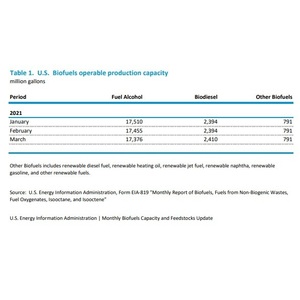EIA: Biofuel capacity falls slightly in March, feedstock use up

June 1, 2021
BY Erin Voegele
The U.S. Energy Information Administration released data on May 28 that shows 20.577 billion gallons of U.S. biofuel production capacity was in place in March, down slightly from 20.64 billion gallons in February.
Fuel alcohol production capacity was down for the period, falling from 17.455 billion gallons in February to 17.376 billion gallons in March. Biodiesel capacity, however, increased from 2.394 billion gallons in February to 2.41 billion gallons in March. Capacity for other biofuels, including renewable diesel, renewable heating oil, renewable jet fuel, renewable naphtha, renewable gasoline and other renewable fuels, held steady at 791 million gallons.
Advertisement
Approximately 23.499 billion pounds of corn went to biofuel production in March, up from 18.717 billion pounds in February. The EIA data shows no grain sorghum was used to produce U.S. biofuels during the month.
According to the EIA, 43 million pounds of poultry fat, 83 million pounds of beef tallow, 64 million pounds of white grease, 226 million pounds of yellow grease and 9 million pounds of other waste oils, fats and greases went to biofuel production in March, compared to 34 million pounds, 66 million pounds, 50 million pounds, 198 million pounds and 3 million pounds, respectively, in February.
A total of 123 million pounds of canola oil was used to produce biofuels in March, up from 85 million pounds in February. Corn oil use was also up, at 195 million pounds, compared to 155 million pounds in February. An additional 740 million pounds of soybean oil went to biofuel production in March, up from 552 million pounds the previous month.
Advertisement
A total of 69 million pounds of other recycled feeds and wastes and other biofuel feedstocks were used to produce fuel in March, compared to 63 million pounds in February.
Related Stories
The USDA on April 14 announced the cancellation of its Partnerships for Climate-Smart Commodities program. Select projects that meet certain requirements may continue under a new Advancing Markets for Producers initiative.
The Michigan Advanced Biofuels Coalition and Green Marine are partnering to accelerating adoption of sustainable biofuels to improve air quality and reduce GHG emissions in Michigan and across the Great Lakes and St. Lawrence Seaway.
The USDA reduced its outlook for 2024-’25 soybean oil use in biofuel production in its latest World Agricultural Supply and Demand Estimates report, released April 10. The outlook for soybean oil pricing was revised up.
EIA reduces production forecasts for biobased diesel, increases forecast for other fuels, including SAF
The U.S. Energy Information Administration reduced its 2025 forecasts for renewable diesel and biodiesel in its latest Short-Term Energy Outlook, released April 10. The outlook for “other biofuel” production, which includes SAF, was raised.
FutureFuel Corp. on March 26 announced the restart of its 59 MMgy biodiesel plant in Batesville, Arkansas. The company’s annual report, released April 4, indicates biodiesel production was down 24% last year when compared to 2023.
Upcoming Events










